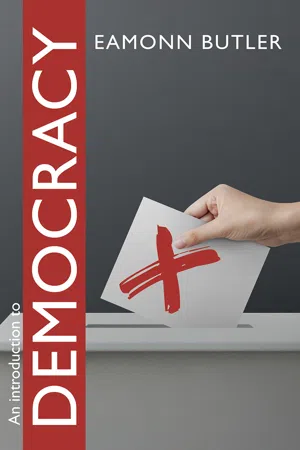
- 140 pages
- English
- PDF
- Available on iOS & Android
Introduction to Democracy
About This Book
What is democracy? How does it work? What are its strengths – and its shortcomings? Two-thirds of the world's population, in over 100 countries, live under governments that claim to be democratic. Yet few of those governments live up to the ideals of democracy, or respect its key principles and institutions. Here, author Eamonn Butler defines democracy, explains its purposes, and shows the difference between genuine democracy and the many sham versions that currently exist. He outlines the history of democracy and the benefits it brings. But he also points out the many myths about it that blind us to its limitations. And he explains why it's important to have a clear understanding of democracy – and how easily it can be lost or abused when people do not properly understand it. Importantly, he asks why so many people today have become disillusioned with democratic politics – and what, if anything, can be done about it. This lucid and fascinating book provides a straightforward introduction to democracy, enabling anyone to understand it – even if they've never experienced it.
Frequently asked questions
Information
Table of contents
- About the author
- 1 Understanding democracy
- What this book is about
- The problem of ‘democracy’
- Limiting democracy
- The attraction of democracy
- More problems of understanding
- The need for clarity
- 2 The history of democracy
- Greek democracy
- The Roman Republic
- The medieval period
- The early modern period
- Constitutional republicanism
- Liberal democracy
- The expansion of democracy ...
- … beyond its limits?
- The death of democracy?
- 3 Democratic institutions
- The purpose and power of government
- The key role of democracy
- Direct democracy
- Representative democracy
- Liberal democracy
- 4 The principles of democracy
- The essentials of liberal democracy
- Desirable elements of liberal representation
- The operation of liberal democracy
- 5 Representative democracies today
- Parliamentary government
- Presidential systems
- Constitutional monarchies
- The role of the public
- Safeguarding the process
- Electoral systems
- Accountability to the public
- The tension between democracy and rights
- 6 The benefits of democracy
- Preventing the accumulation of power
- Absorbing change
- Speaking to our values
- Promoting honest policy
- Criticism and progress
- Protecting individual rights
- Peace and prosperity
- Conclusion
- 7 Criticisms of democracy
- Electors are not up to the job
- It makes inefficient decisions …
- … and bad ones
- It has a short-term focus
- It rests on state power
- It promotes over-large government
- It has unseen costs
- 8 Over-selling democracy?
- Democracy is the best system
- It’s rule by the people
- It’s government by consent
- Everyone has a say
- Democracy promotes equality
- Democracy provides a sense of community
- Democracy protects us from bad rulers
- 9 How democratic decisions are made
- Elections
- Electors
- Candidates
- Legislators
- Officials
- Political dependents
- Conclusion
- 10 Democracy under pressure
- Rejection of establishment politics
- Changing world circumstances
- Changes in the political system
- Changes in the electorate
- Conclusion
- 11 The future of participation
- Forms of participation
- Arguments for participation
- Practical arguments against participation
- Against participation in principle
- Do we really want ‘more democracy’?
- The idea of limited democracy
- 12 Democracy and borders
- The West’s mistakes
- Problems of emergent democracies
- Failed attempts to impose democratic values
- International institutions
- World democracy?
- A system for small groups?
- 13 The lessons of experience
- Do we really want democracy?
- What justifies democracy?
- What would a sustainable democracy look like?
- Alternative democratic systems
- Democracy isn’t everything
- 14 Quotations about democracy
- The tyranny of the majority
- Power corrupts
- The culture of democracy
- Further reading
- Explanations and overviews
- Challenges and critiques
- Other references
- Key terms
- About the IEA
- Blank Page